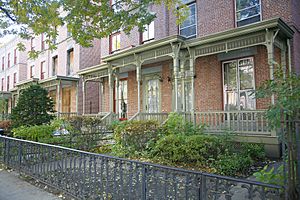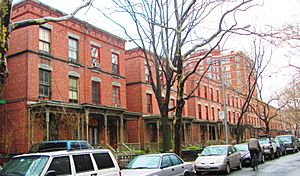Astor Row facts for kids
Astor Row is a special group of 28 row houses in the Harlem neighborhood of Manhattan, New York City. These houses are on the south side of West 130th Street, between Fifth and Lenox Avenues. They were some of the first townhouses built in this area just for selling.
The houses were designed by Charles Buek and built between 1880 and 1883. The land was bought by John Jacob Astor in 1844 for $10,000. His grandson, William Backhouse Astor, Jr., was the main person who pushed for these houses to be built.
These three-story brick houses are quite unique for Manhattan. They are set back from the street, which means they have front and side yards. This is very unusual in a busy city like New York! They also all have wooden porches. The first group of houses (numbers 8 to 22) are built in pairs, standing freely. The rest (numbers 24 to 60) are connected at the back.
On August 11, 1981, the Astor Row houses were officially named New York City Landmarks. This means they are important historical buildings that need to be protected.
History of Astor Row Houses
When William Backhouse Astor died, his grandchildren inherited the houses. The Astor family owned them until 1911. Then, the westernmost 10 houses were sold to a real estate investor named Max Marx.
In 1920, a reporter from The New York Times wrote that Astor Row was "one of the most attractive and exclusive home centers" in Harlem. The reporter said it showed "a picture of domestic tranquility and comfort."
The Astor Row houses were very popular and rented for $1,100 per year. For many years, there was even a waiting list to live there! At first, white families lived in the houses. By 1920, 20 of the 28 houses were bought by James Cruikshank, a real estate operator. He then rented them to black families.
Over time, the houses were not kept up very well, and many of the wooden porches were lost. In 1978, a guide to New York City buildings said the row's beauty had been "tarnished by years of economic distress."
Restoring the Astor Row Houses
In 1981, New York City made the entire row a landmark. This helped raise money to fix them up. Many groups worked together to restore the houses. These included the New York Landmarks Conservancy and the New York City Landmarks Preservation Commission. They helped fix the outside of the houses, and also improved the plumbing, heating, and electrical systems.
In 1992, the famous singer Ella Fitzgerald even performed at a concert to help raise money for the restoration work. By the late 1990s, the beautiful porches and other decorations were restored on almost all the buildings.
In August 2009, The New York Times newspaper wrote that Astor Row was "at the center of an intense but... unfinished revival" of the streets around it in Central Harlem. The restoration of these special houses was managed by Roberta Washington and Li/Saltzman.
See also
 In Spanish: Astor Row (Manhattan) para niños
In Spanish: Astor Row (Manhattan) para niños



